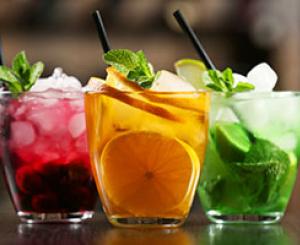
Have you really lived if you’ve never enjoyed the Chilean terremoto on a sizzling summer day?
In their new book The World’s Best Drinks, Lonely Planet has gathered up 100 drink recipes (alcoholic and non-alcoholic) from around the globe, complete with info on each drink’s history. Here are some of the drinks we thought looked most delectable.
The terremoto in Chile
Ingredients: Pipeño (a sweet white wine), pineapple ice cream, bitter (usually Fernet)
The terremoto (Spanish for “earthquake”) starts sweet but finishes with a bitter acidity — and don’t be fooled by its bright, dessert-y colors. This drink will mess you up. The Chilean cocktail is considered a classic but won’t show up on most menus. Seek it out at at places like La Piojera (one of the bars that claims to have invented it) and El Hoyo.
A negroni in Italy
Ingredients: Gin, vermouth, Campari, orange slice or rind
This classic aperitivo is meant to ignite the appetite and has come to be associated with leisure and socializing. The balance of tangy and bitter, citrus and herbs, creates a drink perfect for sipping on a warm summer night.
A Siam sunray in Thailand
Ingredients: Vodka, coconut liqueur, lime juice, simple syrup, soda, ginger, lemongrass, Kaffir lime leaf, Thai chili pepper, lime to garnish
This complex cocktail packs a flavorful punch — the smoothness of the coconut, the bite of the lime, the heat of the chili. It’s a young drink (notable bartender Surasakdi Pantaisong developed it in 2009 as past of a tourism campaign), but it’s quickly gaining popularity — and for good reason.
A Sazerac in New Orleans
Ingredients: Cognac, rye whiskey, or bourbon; absinthe or Herbsaint; sugar syrup; Peychaud’s bitters; lemon zest
New Orleans’s official drink was first developed in the 1830s as a fix for upset stomachs but lived on as people realized it just tastes damn good. It’s a strong mix — spicy, herbaceous, and finishes smooth — and it’s best enjoyed at a French Quarter dive.
A dark and stormy in Bermuda
Ingredients: Dark rum, ginger beer, wedge of lime
The dark and stormy is Bermuda’s national drink, a much-loved treasure with a wide range of sweetness and spice dependent on your brand of rum or ginger beer (just don’t ever substitute ginger ale for ginger beer).
Some canelazo in the Andes
Ingredients: Aguardiente (a sugar-cane distilled rum), fruit juice (orange, naranjillo, or passion fruit), water, brown sugar, lime juice, cinnamon stick, cloves
This Andean-style hot toddy is commonly sold along the highland streets at Christmas and during festivals, filling the air with a strong scent of cinnamon. The drink itself is the ultimate in comfort beverages: sweet, with a kick, and totally refreshing.
The Caesar in Canada
Ingredients: Vodka, Mott’s Clamato juice, hot sauce, Worcestershire sauce, celery salt, salt and pepper, celery stick, lime wedge
The Caesar, developed in 1969 as the Calgary Inn’s signature cocktail, is Canada’s most consumed mixed drink — which means it’s probably worth getting past the “clam broth” barrier.
Pimm’s cup in the U.K.
Ingredients: Pimm’s No. 1, lemonade, lemon juice, cucumber, orange slices, crushed mint, strawberries
No summer picnic is complete without a jug of this ultra-refreshing, sweet-and-sour concoction. And the best part? You can munch on the gin-macerated bits of fruit when the last drop is gone.
Kvas in Russia
Ingredients: Water, bread (black, brown, or rye), dry yeast, sugar
Russians and Ukrainians have been drinking this naturally fermented thirst-quencher for centuries. These days you can find street vendors — who pop up in droves during the summer — serving it on sidewalks across the country, and there’s nothing quite like its fizzy, slightly sour taste to beat the heat.
Some caribou in Quebec
Ingredients: Brandy, vodka, sherry, port, cinnamon stick (optional)
This Canadian cocktail — the unofficial signature drink of Quebec City’s Winter Carnival — can be served chilled or warmed, but either way it’s going to warm you up. Bonus points if you sip it from a Bonhomme cane — a hollow cane topped with the head of the carnival’s snowman mascot.
A caipirinha in Brazil
Ingredients: Cachaça (a rum-like sugar cane-distilled spirit), sugar, mint, lime
Super strong and crazy sweet, the caipirinha goes down like candy — making it tough to stop drinking. The classic recipe is everywhere in Brazil, but look out for variations, too, like the caipiroska (sub vodka instead of cachaça) or the caipifruta (sub mixed fruits instead of lime).
Some glögi in Finland (or glögg in Sweden)
Ingredients: Red wine, blackcurrant or red grape juice, vodka, sugar, cinnamon stick, vanilla pod, whole cloves, cardamom pods, candied orange peel, raisins, blanched slivered almonds
This Scandinavian treasure is everything you want on days when the sun starts setting right around lunchtime: It’s steaming, fragrant, and ideally served with a couple gingerbread cookies.
A paloma in Mexico
Ingredients: Tequila (preferably blanco), grapefruit juice, soda, salt, sugar syrup or honey (optional)
The paloma is a simple drink, more than anything a vehicle for great tequila — the kind you sip instead of shoot. Plenty of variations exist — some bartenders will use super-sugary grapefruit soda instead of club soda and juice, others leave out the salt — but regardless it’s crisp, a little sweet, and definitely more popular than margaritas among locals.
For more information about drinks around the world, please visit BuzzfeedTravel.
